
PowerApps Basics
PowerApps is one of the most recent additions to the Microsoft Office suite of products. PowerApps has been marketed as “programming for non-programmers”, but make no mistake; the seamless interconnectivity PowerApps has with other software products allows it to be leveraged in highly complex enterprise applications. PowerApps basic is included in an Office 365 License, but for additional features and advanced data connections, a plan must be purchased. When I was brought on to CC Pace as an intern to assist with organizational change regarding SharePoint, I assumed that the old way of using SharePoint Designer and InfoPath would be the framework I would be working with. However, as I began to learn more about PowerApps and CC Pace’s specific organizational structure and needs, I realized that it was essential to work with a framework geared towards the future.
Solutions with PowerApps
While Big Data and data warehousing become common practices, data analytics and organized data representation become more and more valuable. On the small to medium organizational scale, bringing together scattered data which is stored in a wealth of different applied business practices and software options has been extremely difficult. This one of the areas where PowerApps can create immense value for your organization. Rather than forcing an extreme and expensive organizational change where everyone submits expense reports, recruitment forms, and software documentation to a brand new custom database management system, PowerApps can be used to pull data from its varying locations and organize it.
PowerApps is an excellent solution for data entry applications, and this is the primary domain I’ve been working in. A properly designed PowerApp allows the end user to easily manipulate entries from all sorts of different database management systems. Create, Read, Update, Delete (CRUD) applications have been around and necessary for a long time, and PowerApps makes it easy to create these types of applications. Input validation and automated checks can even help to prevent mistakes and improve productivity. If your organization is constantly filling out their purchase orders with incorrectly calculated sales tax, a non-existent department code, or forgetting to add any number of fields, PowerApps allows some of those mistakes to be caught extremely early.
Integration with Flow (the upgraded version of SharePoint designer WorkFlows), allows for even greater flexibility using PowerApps. An approval email can be created to ensure to prevent mistakes from being entered into a database management system, push notifications can be created when PowerApps actions are taken, the possibilities are (almost) endless.
Pros and Cons
There are both advantages and disadvantages to leveraging software in an enterprise solution that is still under active development. One of the disadvantages is that many of the features that a user might expect to be included aren’t possible yet. While Flow integration with PowerApps is quite powerful, it is missing several key features, such as an ability to attach a document directly from PowerApps, or to write data over multiple records at a time (i.e. add multiple rows to a SQL database). Additionally, I would not assume that PowerApps is an extremely simple, programming free solution to business apps. Knowledge of the different data types as well as the use of functions gives PowerApps a steep learning curve. While you may not be writing any plaintext code, other than HTML, PowerApps still requires a good amount of knowledge of technology and programming concepts.
The main advantage to PowerApps being new software is just that; it’s brand new software. You may have heard that PowerApps is currently on track to replace, at least partially, the now shelved InfoPath project. InfoPath may continue to work until 2026, but without any new updates to the program, it may become obsolete on newer environments well before that. Here at CC Pace, we focus on innovation and investing in the solutions of tomorrow, and using PowerApps internally rather than creating a soon non-supported InfoPath framework was the right choice.
Author Bio
As a programmer and cybersecurity enthusiast, creating pieces of enterprise systems is something I never knew I would be so interested in. I’m Niels Verhoeven, a summer IT Intern at CC Pace Systems. I study Information Systems with a focus on Cybersecurity Informatics at University of Maryland, Baltimore County. My experiences at CC Pace and my programming background have given me quite a bit of insight into how users, systems, and business can fit together, improving productivity and quality of work.
More from the blog
View All Blog PostsSubscribe to Our Blog
Fill out your email address to receive notifications about new blog posts from CC Pace!
